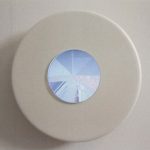Paul Smith: randomSeed 001
Artist(s):
Title:
- randomSeed 001
Exhibition:
- SIGGRAPH 2006: Intersections
-
More artworks from SIGGRAPH 2006:


Medium:
- Computational image
Size:
- 22" x 22"
Category:
Artist Statement:
The randomSeed works were developed after extensive research into computational models used in the study of artificial life. In part, this was undertaken during boredomresearch’s residency at Artsway in the New Forest, United Kingdom (2002-2003). During this time, the artists deconstructed the process of building computational program-dependent artworks. Reversing the normal trend of translating physical properties into electronic form, boredomresearch de-digitised their artistic practice, converting programmed works into a paper-based form. This led to an interest in computational models that predated electronic computing. In particular, the artists were fascinated by cellular automata. Despite the fact that it is now predominantly being created on computers, this technique for modelling artificial life was originally executed on graph paper and allegedly conceived using broken plates on the tiled floor of its inventor’s (John Conway) kitchen. This drew the artists’ attention to the high level of visual complexity that can be achieved from the repeated execution of very simple rules, and they developed an extensive range of cellular automata-based rules and systems before finally arriving at the ones implemented in randomSeed.
It is all too easy to simply think of space as the stuff we move around in and time as duration. For boredomresearch, the interesting quality of cellular automata is the incredibly intricate patterns revealed as a product of their space-time continuum. Viewed as a static image, time is no longer the perception of change but something more beautiful. In randomSeed, the image represents a record of the machine’s movements and can also be thought of in this way.
boredomresearch are interested in how they can’t predict the images created as the machines respond to their environment. The main attraction in building this work is observing the different outcomes of the innumerable permutations that are outside of the artists’ aesthetic control.
Technical Information:
In randomSeed, tiny creature-like objects can be observed busily moving about in encapsulated worlds, like “workers” in an ant’s nest. boredomresearch have created simple movement instructions for their “workers” (which they refer to as machine heads). They march out from the centre of their world, leaving movement traces by changing pixel colour.
The audience finds itself absorbed by the intricate and beautiful images the machine heads make by following simple rules. Eventually, the machine heads fill their world with different coloured pixels and can no longer move in straight lines. Their behaviour changes as their environment becomes increasingly complex. Finally, their world takes on a textured appearance similar to granite.
By slightly varying the machine-head instructions within different systems, randomSeeds can create a huge range of diverse images. In one randomSeed system, machine heads leaving the circle return to the opposite side; in the other system, they are placed back in the center. After running both these systems for a couple of months, you can appreciate the subtle differences in how the images develop. But however many times a system is relaunched, the artists still find themselves surprised by the beauty and intricacy of the images.






